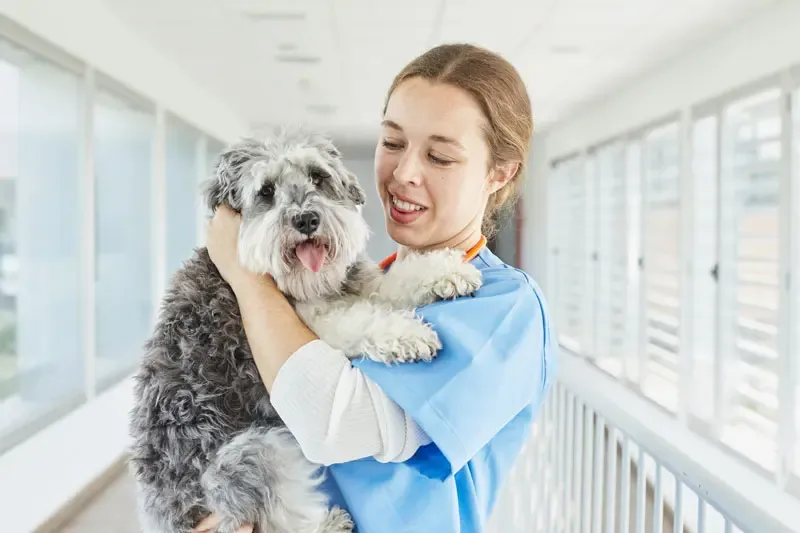It is usually measured over a 1 minute period . Other vital signs that are useful in veterinary medicine are temperature , heart rate and blood pressure .
How is respiratory rate measured?
Respiratory rate should always be measured as a routine habit that forms part of all physical exams . The respiratory rate is simply a count of the number of breaths per minute. As the dog’s ribcage and abdomen move when it breathes, these movements can be counted over a 1 minute to provide the respiratory rate. Standing in front or behind the dog provides the best view of its chest and abdominal movements. These movements are harder to detect from the side. When it is difficult to observe the movements, the measurement can be assisted by palpating the chest to detect each breath the patient takes.
Instead of measuring the respiratory movements for an entire minute, vets often measure them for 15 or 30 seconds . These counts are then multiplied by four or two, respectively, to obtain the number of breaths per minute.
Before measuring the respiratory rate in dogs, first ensure the animal is at rest , as respiratory rate increases with physical exercise, so a temporary physiological state could be interpreted as an abnormal value.
What are the normal ranges of respiratory rate?
As indicated above, the respiratory rate is not a static parameter. Respiratory rate normally changes when there is an increase or decrease in metabolism and in the case of damage to the lungs and/or respiratory centres . Since an increase or decrease in metabolism can produce changes in respiratory rate, the rate varies according to the dog’s stage of life , breed , temperature and level of physical activity .
We can generally assume that a normal rate is between 10 and 30 breaths per minute, but it is important to be aware of variations between different breeds to avoid interpreting a physiological phenomenon as a sign of disease:
- In large dogs the respiratory rate is about 15 breaths per minute, and in a small dog it is usually around 25 breaths per minute.
- Another consideration is that puppies breathe about 20 times per minute.
What causes the respiratory rate in dogs to increase or decrease?
Both increases and decreases in respiratory rate can be caused by either a disease or a physiological condition. If the dog is at rest and the respiratory rate adjusted for age and size, we can quickly determine whether the animal’s rate is within a normal or pathological range.
Causes of increased respiratory rate
An increased respiratory rate is known as tachypnoea and may or may not be accompanied by shortness of breath, known as dyspnoea . Tachypnoea is usually due to a decrease in the level of oxygen in blood. This decrease may occur because:
- Not enough oxygen reaches the alveoli due to a problem in the respiratory tract , such as a foreign body or a mechanical dysfunction of the muscles1, trauma or a neuromuscular disease.
- There is insufficient gas exchange as a result of, for example, cardiogenic pulmonary oedema.
- There is a decline in the ambient partial pressure of oxygen , e.g., increased altitude.
Furthermore, there might be a sufficient level of oxygen , but the animal’s body cannot transport and release it in the tissues correctly, such as in the case of anaemia or certain types of poisoning that obstruct oxygen’s passage to the tissues.
This group of potential causes also includes the formation of thrombi in the pulmonary vessels.
Finally, various other causes should be noted such as psychogenic causes, pain , fever and physiological compensation after exercise.
Causes of decreased respiratory rate
A decreased respiratory rate in dogs (known as bradypnoea ) is usually secondary to the inhibition of the respiratory nerve centres that control breathing movements, as occurs in certain types of poisoning . It may also be secondary to muscle fatigue following persistent compensatory tachypnoea and may even occur due to a multifactorial mechanism in critically ill dogs.
Conclusions
The respiratory rate in dogs is a basic and easily measured parameter that should always be recorded, as it can provide a lot of information about the animal’s clinical condition. It should be assessed in conjunction with all the other clinical signs and parameters when making a diagnosis. Accordingly, to make a correct diagnosis, we must never lose sight of the animal’s overall clinical picture , observing the respiratory rate and other vital signs as well as other factors that provide information about the animal’s general health status such as its body condition.
It is also important to analyse the data obtained from the patient’s medical history , as comorbidities could affect the values returned from vital sign measurements. We have already mentioned that the respiratory rate in dogs varies according to metabolism, size and even depends on the dog’s physical condition.This last point must be considered, for example, in the case of obese dogs.
So the respiratory rate in dogs , assessed within its context and in relation to other clinical signs, can be a very useful tool when treating patients.








